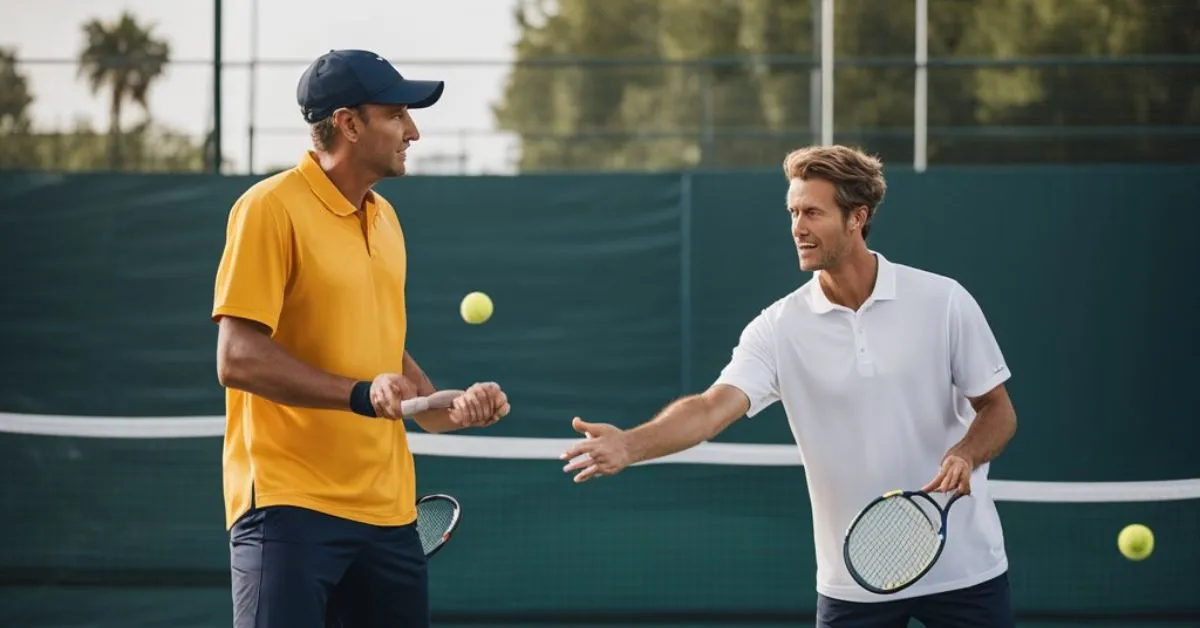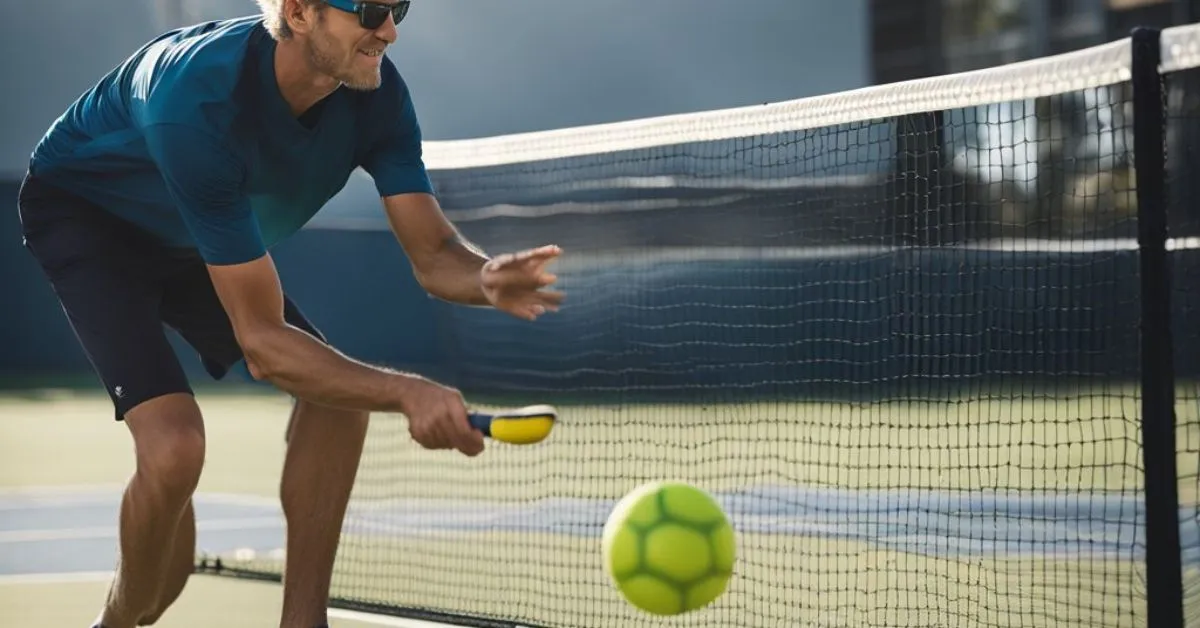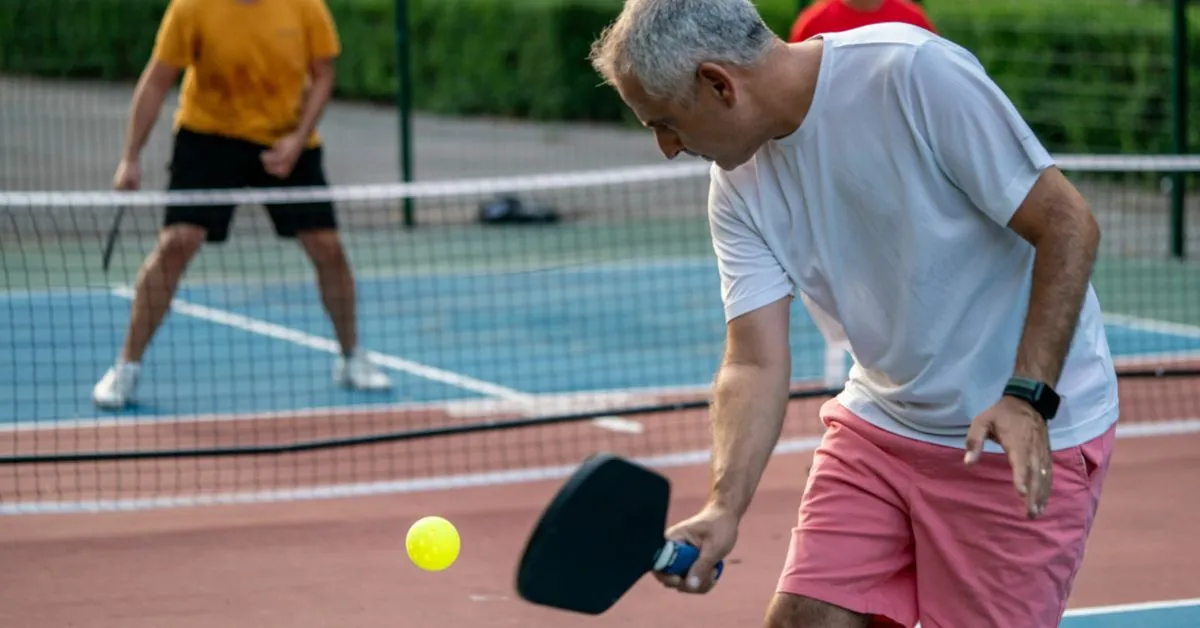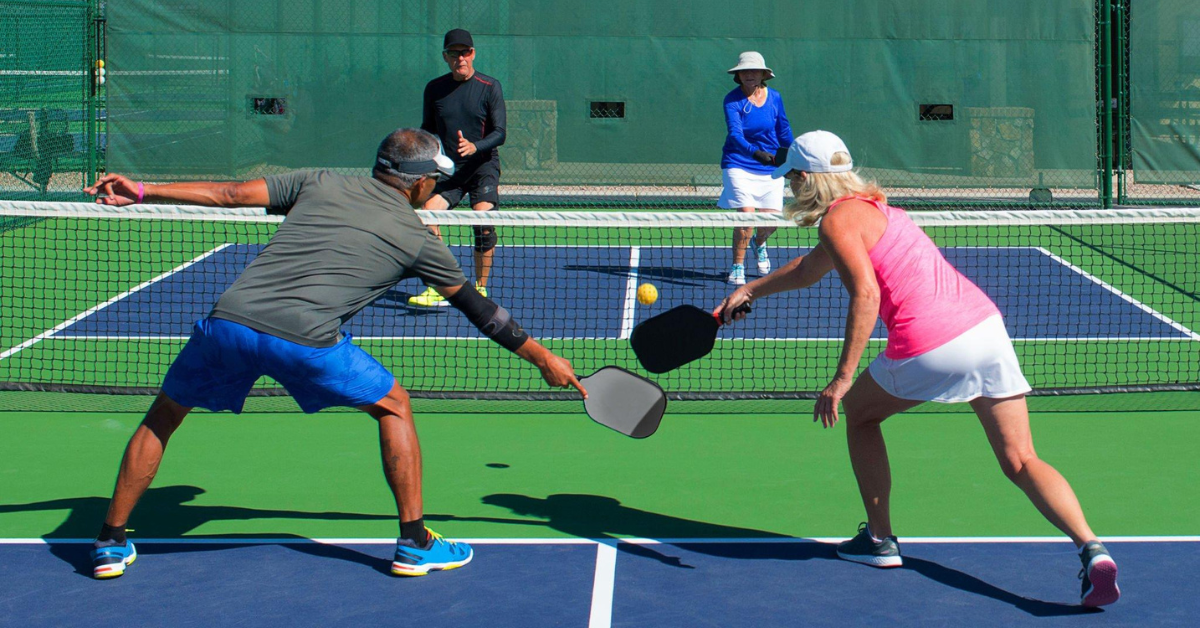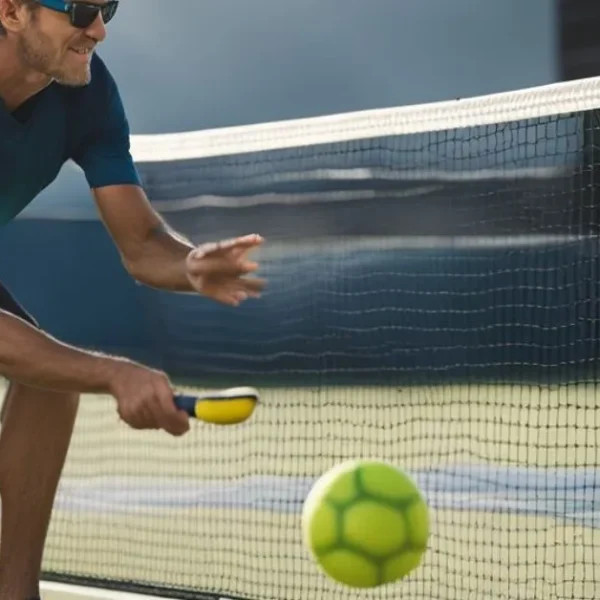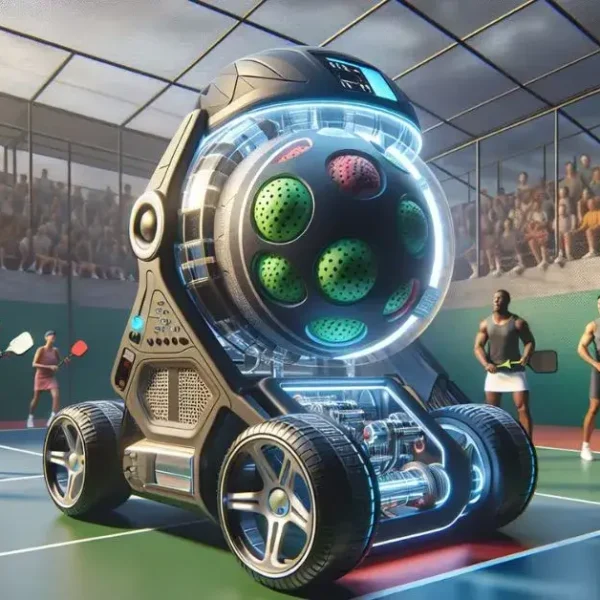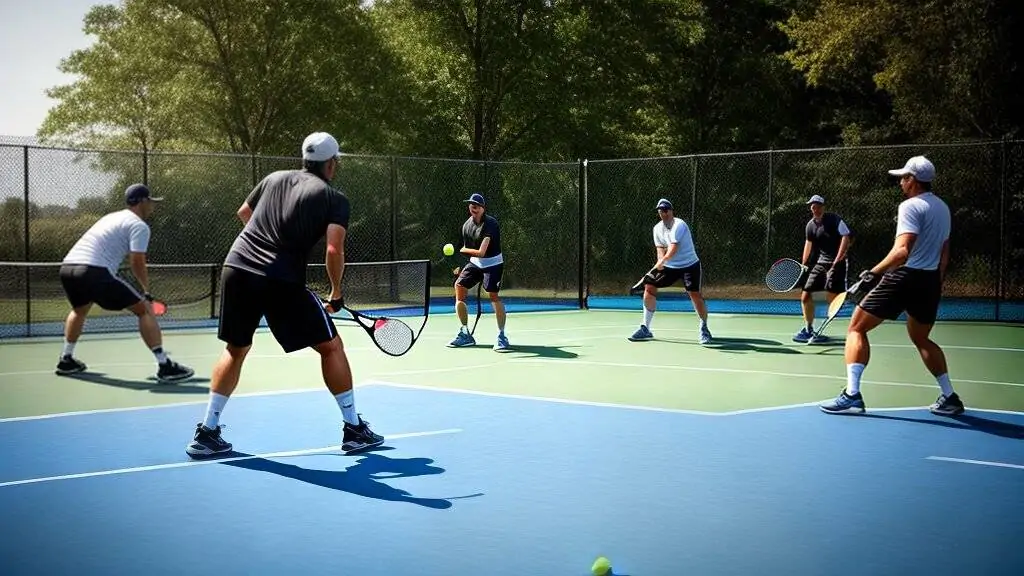Pickleball doubles strategy is essential for success in this fast-paced and dynamic sport. Whether you’re a beginner or a seasoned player, understanding effective doubles strategies can significantly improve your game. By working closely with your partner and implementing strategic plays, you can gain a competitive edge on the court.
One key aspect of pickleball doubles strategy is effective communication and positioning with your partner. Clear communication and coordinated movements are vital for anticipating shots and covering the court efficiently.
Additionally, mastering the art of teamwork and understanding each other’s strengths and weaknesses can greatly enhance your overall performance as a doubles team.
In this article, we will delve into various pickleball doubles strategy tips, including positioning, shot selection, and teamwork. By exploring these strategic elements, players can elevate their doubles game and approach each match with confidence and skill.
Key Takeaways:
- Effective doubles pickleball strategies are crucial for success.
- Communication and teamwork are essential in doubles pickleball.
- Patience and selective shot selection can create opportunities for victory.
- Using cross-court dinks can widen opponents’ defense and build patience.
- Moving as one and synchronizing movements improves positioning on the court.
Practice Patience
Patience is a crucial strategy in doubles pickleball. Instead of rushing to attack every shot, it’s important to be selective and recognize that not every opportunity is the right time to strike. Both teammates must practice patience and communicate effectively to avoid making unnecessary mistakes. By implementing patient play, you can create opportunities for success and confuse your opponents.
When practicing patience in pickleball, it’s essential to focus on selective shot selection. This means choosing shots that have a higher probability of success rather than attempting low-percentage shots that may result in errors. By being patient and waiting for the right opportunities, you can increase your chances of executing successful shots and winning points.
Another key aspect of practicing patience in doubles pickleball is communication with your partner. Effective communication allows you and your partner to coordinate your movements and shot selection, ensuring that you both are on the same page during the game. By communicating your intentions and discussing strategy, you can make informed decisions together and maximize your chances of success.
Benefits of Practicing Patience in Doubles Pickleball
- Improved shot selection
- Reduced errors and unforced mistakes
- Confusion and frustration for opponents
- Better coordination and teamwork with your partner
Strategies for Implementing Patience in Doubles Pickleball
- Wait for high-percentage shots
- Avoid rushing into low-percentage shots
- Communicate with your partner about shot selection
- Focus on consistency rather than aggressive play
- Stay calm and composed during intense rallies
Examples of Shot Selection Based on Patience
| Shot Opportunity | Patience Approach | Impatient Approach |
|---|---|---|
| High lob near the baseline | Wait for the ball to drop before returning with control | Attempt a difficult overhead smash that may result in an error |
| Short drop shot near the net | Approach the ball patiently and execute a soft touch shot over the net | Rush towards the net and attempt an aggressive put-away shot |
| Fast-paced rally with quick exchanges | Focus on consistent and controlled shots to maintain the rally | Try to end the rally quickly with a risky winner attempt |
Practicing patience in doubles pickleball can lead to better shot selection, reduced errors, and improved coordination with your partner. By waiting for the right opportunities and communicating effectively, you can elevate your game and increase your chances of success. Remember, pickleball is a game of strategy and finesse, and patience is a key ingredient in achieving victory.
Use Cross-Court Dinks
One effective strategy to incorporate into your pickleball doubles game is cross-court dinking. This technique involves hitting the ball diagonally to the opposite side of the court, forcing your opponents to widen their defense. By utilizing cross-court dinks, you create more challenging angles for your opponents to cover, making it harder for them to anticipate and react to your shots. This strategy not only helps in building patience but also keeps your opponents guessing and off balance.
To successfully execute cross-court dinks, it is essential to practice and refine your technique. Work on your control and placement, aiming for the corners of the court to maximize the effectiveness of your shots. Additionally, diversify your dinking strategy by incorporating different speeds and spins, further confusing your opponents and forcing them into defensive positions.
By employing cross-court dinks in your doubles pickleball game, you can widen your opponents’ defense, create opportunities for strategic shots, and maintain control of the point. Continued practice and mastery of this strategy will undoubtedly enhance your overall performance on the court.
Table: Examples of Cross-Court Dinking
| Player Name | Court Side | Shot Placement |
|---|---|---|
| Player 1 | Right | Diagonal shot to opponent’s right corner |
| Player 2 | Left | Diagonal shot to opponent’s left corner |
| Player 1 | Left | Diagonal shot to opponent’s right corner |
| Player 2 | Right | Diagonal shot to opponent’s left corner |
Move as One
In doubles pickleball, synchronized movement is a vital strategy that can greatly enhance your performance on the court. By moving as a cohesive unit with your partner, you can position yourselves effectively, cover the court efficiently, and create a seamless flow of play. Being attuned to each other’s movements allows you to anticipate each other’s actions and react quickly to your opponents’ shots.
Effective communication is key to successful synchronized movement. Constantly communicate with your partner about your positioning, intentions, and strategy. This will help you both make split-second decisions and adjust your movements accordingly. By staying connected and in sync, you can avoid collisions, maintain proper court coverage, and maximize your gameplay.
Positioning on the Court
Proper positioning is crucial for executing synchronized movement in doubles pickleball. Position yourselves strategically on the court based on the situation. When your partner is at the baseline, move closer to the non-volley zone to be ready for a quick transition. Alternatively, if your partner is at the non-volley zone, move back towards the baseline to provide support and cover the backcourt.
Additionally, consider the strengths and weaknesses of your opponents when positioning yourselves. Identify their dominant shots and try to position yourselves to minimize the impact of those shots. By strategically positioning yourselves, you can create a tighter defense and exploit your opponents’ vulnerabilities.
Attuned to Each Other’s Movements
Being attuned to each other’s movements requires practice and familiarity with your partner’s playing style. Spend time on the court together, honing your teamwork and developing an understanding of each other’s strengths and preferences. This will enable you to anticipate each other’s movements, react swiftly, and execute coordinated plays.
Pay close attention to your partner’s body language and cues to determine their intentions. This can include subtle gestures, eye contact, or verbal cues. By being attuned to each other’s movements, you can synchronize your actions and respond effectively to your opponents’ shots, giving you a competitive edge in doubles pickleball.
Serve Deep
One of the most effective strategies in doubles pickleball is serving the ball deep. By delivering a powerful and well-placed serve that lands deep in the opponents’ court, you force them to stay back near the baseline, limiting their options for an aggressive return. This strategy can be particularly beneficial when facing opponents who prefer to play at the net, as it disrupts their positioning and forces them to abandon their preferred strategy.
When serving deep, it’s crucial to focus on accuracy and power. Aim to hit the serve close to the baseline, making it challenging for your opponents to return the ball with precision. By serving deep, you create a more challenging situation for your opponents, forcing them to hit defensive shots and giving you the advantage in the rally.
A deep serve also sets up an advantageous third shot. When your serve forces your opponents to stay back, it opens up the opportunity for you and your partner to move forward and take control of the net. This can lead to more aggressive plays and increased chances of winning the point. Practice serving deep and strategize with your partner to capitalize on the advantageous third shot.
Pickleball Doubles Strategy: Targeting Opponents’ Feet
One effective strategy in doubles pickleball is strategically targeting your opponents’ feet. By aiming your shots at their feet, you create a challenging situation for them to return the ball without making errors. This strategy increases the chances of causing mistakes and gaining an advantage in the rally.
Targeting opponents’ feet is particularly effective when they are positioned near the non-volley zone. Hitting the ball at their feet makes it difficult for them to execute a clean shot, often resulting in a weaker return or a pop-up, which gives you an opportunity to take control of the point.
Maintaining Accuracy and Control
To successfully execute shots aimed at opponents’ feet, it is crucial to maintain accuracy and control. Practice your shot placement and aim to consistently hit the ball low and at the feet of your opponents. This requires precision and timing, as well as the ability to read your opponents’ positioning on the court.
Additionally, communication with your partner is essential when implementing this strategy. By communicating your intentions and coordinating your shots, you can maximize the effectiveness of targeting opponents’ feet and create confusion and frustration for your opponents.
Remember, the objective is not to injure or harm your opponents but to strategically place shots that force them into difficult situations. By mastering this doubles pickleball strategy, you can increase your chances of causing errors and gain a competitive advantage on the court.
| Advantages of Targeting Opponents’ Feet | Disadvantages of Targeting Opponents’ Feet |
|---|---|
| Increases chances of causing errors Creates challenging situations for opponents Allows for easier ball control | Requires precise shot placement Dependent on opponents’ positioning May require practice and coordination with partner |
Master Drop Shots
The drop shot is a highly effective strategy in doubles pickleball that can completely disrupt your opponents’ rhythm and give you control over the point. By executing a soft and gentle shot that drops just over the net into the non-volley zone, you force your opponents to hit the ball on an upward trajectory, making it easier for you to respond with an aggressive return shot. The key to successful drop shots lies in precise execution and the element of surprise.
When executing a drop shot, focus on a delicate touch and finesse rather than power. Find the right angle and trajectory to make the ball fall just inches over the net. Aim to land the drop shot in a spot that will cause your opponents to move quickly and stretch for the ball. This will force them out of position and give you the opportunity to gain control of the rally.
It’s crucial to vary your drop shot placement and disguise your intentions. Aim for different areas of the court, targeting both sidelines and the middle. By keeping your opponents guessing, you’ll make it harder for them to anticipate and react to your shots. With practice and experience, you’ll develop the ability to execute drop shots with precision and use them strategically to gain the upper hand in doubles pickleball.
Benefits of the Drop Shot Strategy:
- Disrupts opponents’ rhythm: The drop shot forces your opponents to change their plan and adjust their positioning, disrupting their rhythm and increasing the likelihood of errors in their return shots.
- Gains control of the point: By executing well-placed drop shots, you can take control of the rally and put your opponents on the defensive, allowing you to dictate the pace and direction of the game.
- Creates opportunities for aggressive shots: When your opponents are forced to hit an upward trajectory shot, they are more likely to provide you with a setup that can be attacked aggressively, putting you in a favorable position to win the point.
| Shot Placement | Advantages |
|---|---|
| Down the middle | Creates confusion between opponents, leading to miscommunication and missed shots. |
| Sidelines | Increases the distance and difficulty for opponents to reach the ball, creating opportunities for errors. |
| Opponents’ weaker side | Exploits the weaker side of your opponents, increasing the chances of them making mistakes. |
Mastering the drop shot strategy requires practice and patience. With time, you’ll develop the necessary touch and control to execute drop shots effectively. Combine this strategy with other doubles pickleball techniques to create a well-rounded game that keeps your opponents off balance and maximizes your chances of victory.
Conclusion
Incorporating advanced pickleball doubles strategies can significantly improve your game. By practicing patience, utilizing cross-court dinks, moving as one, serving deep, aiming for the feet, mastering drop shots, and using the non-volley line to your advantage, you and your partner can elevate your doubles pickleball performance and increase your chances of winning.
Remember to communicate effectively with your partner and adapt your strategies based on your opponents’ strengths and weaknesses. Effective communication is crucial in doubles pickleball to ensure coordinated play and optimal decision-making. By sharing information, discussing game plans, and supporting each other, you can create a solid partnership that thrives on teamwork.
Keep practicing and refining your skills to become a formidable doubles pickleball team. Regular practice allows you to develop muscle memory, improve your reactions, and enhance your overall gameplay. Additionally, analyzing your performance and seeking feedback from coaches or experienced players can help identify areas for improvement and fine-tune your strategies.
FAQ
-
What are some advanced pickleball doubles strategies?
Some advanced pickleball doubles strategies include practicing patience, utilizing cross-court dinks, moving as one, serving deep, aiming for the feet, mastering drop shots, and using the non-volley line to your advantage.
-
How can patience be incorporated into doubles pickleball strategy?
Patience can be incorporated into doubles pickleball strategy by being selective with shot selection and recognizing that not every opportunity is the right time to strike. Practicing patience and effective communication with your partner can help avoid making mistakes and create opportunities for success.
-
How can cross-court dinking be effective in doubles pickleball?
Cross-court dinking can be effective in doubles pickleball as it forces opponents to widen their defense, making it harder for them to cover the court effectively. It also helps in building patience. By practicing drills to improve cross-court dinks and diversifying your dinking strategy, you can keep opponents guessing and gain an advantage.
-
Why is moving as a single unit important in doubles pickleball?
Moving as a single unit is important in doubles pickleball because it allows you and your partner to synchronize your movements and be attuned to each other’s playstyles. This strategy positions you effectively on the court, making it harder for opponents to find weak spots between you and enabling you to cover the court more efficiently.
-
How can deep serves enhance doubles pickleball strategy?
Deep serves can enhance doubles pickleball strategy by forcing opponents to stay back near the baseline, creating a more challenging situation for them to return the ball effectively. Deep serves also set up advantageous third shots, giving you an opportunity to control the point. Focusing on accuracy and power in your serves keeps opponents on their toes and increases your chances of success.
-
Why is aiming for your opponents’ feet a valuable doubles pickleball strategy?
Aiming for your opponents’ feet is a valuable doubles pickleball strategy because it makes it difficult for them to return the ball without popping it up, increasing the chances of errors. By practicing accuracy and consistently targeting your shots at your opponents’ feet, you put them in uncomfortable positions and gain an advantage in the rally.
-
How can drop shots be incorporated into doubles pickleball strategy?
Drop shots can be incorporated into doubles pickleball strategy by executing a soft, gentle shot that drops just over the net into the non-volley zone. This disrupts opponents’ rhythm and gives you control of the point. The upward trajectory of their return shot makes it easier for you to respond with an aggressive return shot, increasing your chances of winning the point.
